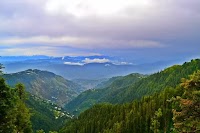At a distance of 120 km from the border of Afghanistan, Bolan Pass is a mountain pass in Balochistan Province of Pakistan which connects the Jacobabad and Sibbi to the Quetta city.
This pass has a significant history background being a mountain pass, which connects the Central Asia and South Asia. Along Bolan Pass where the road winds through picturesque mountains one is reminded of the huge odds that the armies from Central Asia and the South must have faced in their raids on the plains of the present day Pakistan.
In 1837, threatened by a possible Russian invasion of South Asia via the Khyber and Bolān Passes, a British envoy was sent to Kabul to gain support of the Emir, Dost Mohammed. In February 1839, the British Army under Sir John Keane took 12,000 men through the Bolān Pass and entered Kandahar, which the Afghan Princes had abandoned; from there they would go on to attack and overthrow Ghazni. In 1883, Sir Robert Groves Sandeman negotiated with the Khan of Kalat, Khudadad Khan, and secured British control over the pass in exchange for an annual fee.
Bolaln Pass Railway, passing through 21 tunnels (Miracle of Engineering)
One of the greatest Engineering feats of British rule in India was to lay a railway track through the famous Bolan Pass. More than a century old, this railway track still generates an awe among rail enthusiasts all over the world.
Orders for a feasibility survey of Bolan Pass Railway were first issued by the British Government in 1876. Work on the construction of railways through the Pass started in 1880 but was soon stopped after laying of 31 km track due to the occurrence of famous ‘battle of Maiwind’ in thearea. Work restarted in 1885 by rapidly laying a rail track in the bed of river Bolan and finally a steam locomotive rolled into Quetta in August of 1886. The present day railway track through Bolan Pass is the third attempt of laying railways through the pass. In 1889 a torrential flood destroyed the track which was first laid on Bolan River bed. A new track was laid at a higher altitude but that also got washed away. In 1890 orders were issued for laying an all season track through the Pass. This new track was inaugurated on April 15, 1897 and it is still operational. At some places along the track one can see the abandoned tunnels and the rail bed of earlier two attempts of laying railways here.
There are 21 tunnels en-route from Sibi to Quetta and the track crosses River Bolan numerous times in a criss-cross journey. The photo to the right shows a section of sequential tunneling through Bolan Pass.
For a tourist who wishes to travel through Bolan Pass by rail, a variety of trains and accommodation are available.
For a tourist who wishes to travel through Bolan Pass by rail, a variety of trains and accommodation are available.
If in life you find a chance to visit the Bolan Pass you should choose the railway as, it would be one of a kind rail experience anywhere in the world.





